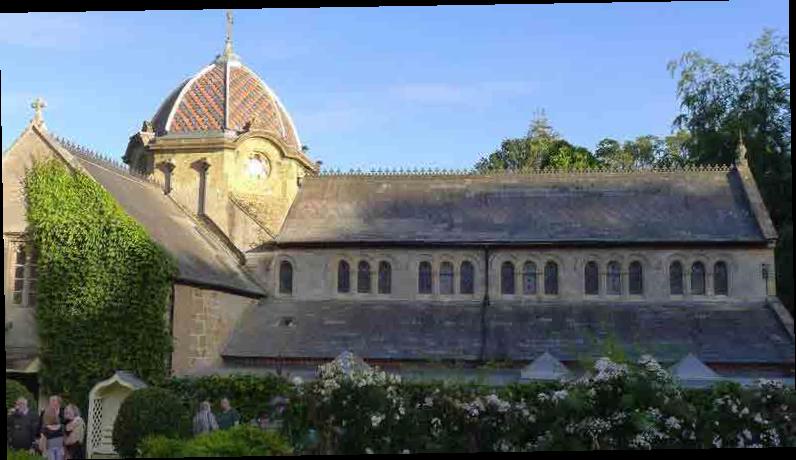
Seven Chideock men - three priests and four laymen - were cruelly put to death for their Catholic faith between 1587 and 1642, whereas an eighth, John Jessop, died in prison. The church of Our Lady, Queen of Martyrs, and St Ignatius, is a memorial to them and to all those who kept the faith throughout the times of bloody repression. Chideock Castle was built by John de Chideocke in 1380. In the late Middle Ages, it passed into the hands of the Arundells of Lanherne, a powerful West Country family. When the old religion was banned, the Arundells remained loyal to their faith, and the castle became a refuge for priests where local Catholics could attend Mass. The Arundells left Chideock when the castle was destroyed in the Civil War, but the local people kept the faith and worshipped in secret in the loft of a barn next to the site of the present Manor House.
The martyrs are commemorated at their place of execution in South Walks Road, Dorchester, by a life-size bronze monument in memory of all the Dorset Martyrs. The first to suffer martyrdom, in 1587, was the Jesuit, Thomas Pilchard, who was concealed at Chideock Castle. While at the castle, Fr Pilchard SJ made many converts, including Thomas Pike, a Chideock carpenter. Pilchard was arrested along with Pike and another companion, John Jessop, described as a gentleman. Pilchard was hanged, drawn and quartered in Dorchester in 1587, whereas Pike remained in prison until being butchered in 1594, and John Jessop died in 1588 in Dorchester prison. John Conor O’Mahoney, later known as John Cornelius, became a priest and ministered to Lady Arundell at Chideock Castle, where he also made a number of converts. In 1594 Cornelius was betrayed and arrested in Chideock Castle with his two servants, Patrick Salmon and John Cary, and a kinsman of Lady Arundell, Thomas Bosgrove. Fr Cornelius became a Jesuit while in prison, and all three martyred together that same year. The last of the Chideock Martyrs was Hugh Green, a Protestant convert who became a Catholic priest and chaplain to the Arundell family. He was arrested, and, while in prison, converted two criminals, and was hanged, drawn and quartered in 1649. In 1802, Thomas Weld, a relation of the Arundells and from an old Catholic family, bought the Chideock estate for his son Humphrey, who built the present Manor House, and turned the barn into a chapel. It was Humphrey’s son, Charles, who then transformed the chapel into the beautiful church we know today. The church, one of the gems of English Catholicism, is dedicated to Our Lady, Queen of Martyrs, and to St Ignatius, founder of The Society of Jesus. It was built by Charles Weld in the grounds of Chideock Manor - home to the Weld family for 200 years - and finished in 1872.
Weld designed the church in the Italian Romanesque style and did much of the work himself, including the wall decorations, the high altar and the side chapels, and the sculpted capitals of the nave pillars. The earlier chapel became the transepts of the new church, the nave and aisles were brought out at right angles, and the high altar was moved to its present position. The front of the church recalls the early churches of Tuscany. A stunning roundel in painted terracotta above the entrance features a statue of Our Lady, Queen of Martyrs, encircled by her Seven Sorrows. Above the high altar is a very fine gilded statue of Our Lady in the Baroque style, dramatically lit from the dome above. The portraits over the arches on each side of the nave depict the English Martyrs and were painted by members of the Weld family. Parts of the original barn chapel, which were also painted by the Weld family, can be seen in the current sacristy, and there is access from here to the barn’s loft where Mass was held in secret. The sacristy and loft can be visited by arrangement. The barrel-vaulted roof is decorated to Charles Weld’s designs, and the reredos behind the altar was decorated by Charles’s family, and represents the Weld patrons, St Edmund, St Lucy, St Humphrey, and St Apollonia. Two Italian marble statues of Our Lady and St Joseph stand in the sanctuary. A gallery overlooking the sanctuary was used by the Weld family, and had direct access from the manor. The church has relics of the True Cross and of fragments of Our Lady’s veil from Chartres, a piece of St Thomas More’s hair shirt and relics of St Cuthbert Mayne. Underneath the altar are the relics of St Mecius, a boy martyred in ancient Rome. The side altars are dedicated to the Sacred Heart and St Ignatius of Loyola respectively.
